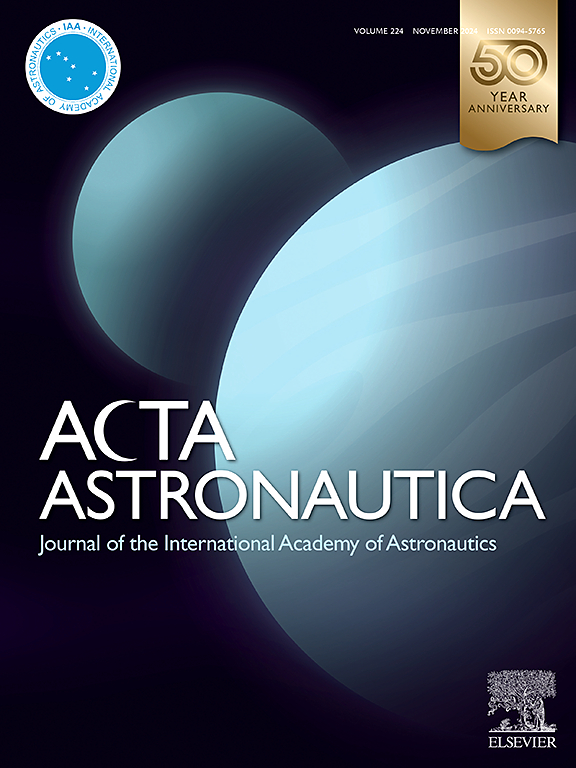空间天气调查前沿(SWIFT)任务概念:从日地L1和次L1有利位置对日球层结构进行连续、分布式观测
IF 3.4
2区 物理与天体物理
Q1 ENGINEERING, AEROSPACE
引用次数: 0
摘要
沿着拉格朗日点L1 (sub-L1)及其内部的日地线进行连续的原位多点观测,将有助于更好地了解驱动地球空间天气的日球层结构的三维结构和时间演变。拟议的SWIFT(空间天气调查前沿)任务将使用美国国家航空航天局开发的一种新的太阳帆推进系统,使一套小型卫星上的科学仪器能够长时间地沿着太阳-地球线(sub-L1)进行观测。位于L1点的三艘装备相同的小型航天器将在优化的四面体星座中与位于亚L1点的航天器协同飞行,覆盖范围在地球半径的10到100倍之间。通过揭示小到中尺度太阳风结构和宏观尺度结构的亚结构(如行星际日冕物质抛射(ICMEs)和流相互作用区(SIRs)的空间特征、时间演变和地理有效性,这种观测几何结构将使科学家能够区分驱动空间天气的局部和全球过程。此外,从sub-L1对地球日球层结构的实时测量将使我们目前的预测提前时间提高35%。本文将概述SWIFT的科学和任务概念。本文章由计算机程序翻译,如有差异,请以英文原文为准。
Space Weather Investigation Frontier (SWIFT) mission concept: Continuous, distributed observations of heliospheric structures from the vantage points of Sun-Earth L1 and sub-L1
Continuous, in-situ, multi-point observations along the Sun-Earth line at and inside the Lagrange point L1 (sub-L1) will enable a better understanding of the three-dimensional structure and temporal evolution of heliospheric structures that drive terrestrial space weather. The proposed SWIFT (Space Weather Investigation Frontier) mission will use a new solar sail propulsion system developed by NASA to enable a suite of science instruments onboard a smallsat to maintain observations along the Sun-Earth line, sub-L1, for extended periods. Three identically instrumented small spacecraft at L1 will fly in concert with the sailcraft at sub-L1 in an optimized tetrahedron constellation, covering scales between 10 and 100s of Earth radii. This viewing geometry will enable scientists to distinguish between local and global processes driving space weather by revealing the spatial characteristics, temporal evolution, and geo-effectiveness of small-to meso-scale solar wind structures and substructures of macro-scale structures, such as interplanetary coronal mass ejections (ICMEs) and stream interaction regions (SIRs). In addition, real time measurements of earth-bound heliospheric structures from sub-L1 will improve our current forecasting lead-times by up to 35 percent. This paper will provide an overview of the proposed SWIFT science and mission concept.
求助全文
通过发布文献求助,成功后即可免费获取论文全文。
去求助
来源期刊

Acta Astronautica
工程技术-工程:宇航
CiteScore
7.20
自引率
22.90%
发文量
599
审稿时长
53 days
期刊介绍:
Acta Astronautica is sponsored by the International Academy of Astronautics. Content is based on original contributions in all fields of basic, engineering, life and social space sciences and of space technology related to:
The peaceful scientific exploration of space,
Its exploitation for human welfare and progress,
Conception, design, development and operation of space-borne and Earth-based systems,
In addition to regular issues, the journal publishes selected proceedings of the annual International Astronautical Congress (IAC), transactions of the IAA and special issues on topics of current interest, such as microgravity, space station technology, geostationary orbits, and space economics. Other subject areas include satellite technology, space transportation and communications, space energy, power and propulsion, astrodynamics, extraterrestrial intelligence and Earth observations.
 求助内容:
求助内容: 应助结果提醒方式:
应助结果提醒方式:


